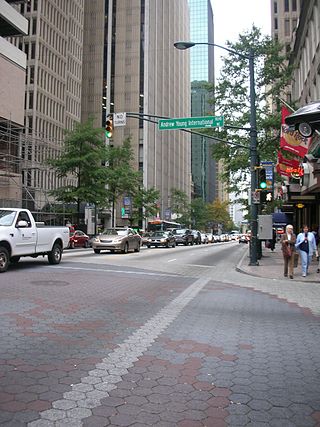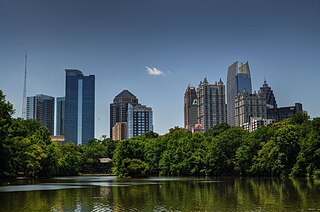
The history of Atlanta dates back to 1836, when Georgia decided to build a railroad to the U.S. Midwest and a location was chosen to be the line's terminus. The stake marking the founding of "Terminus" was driven into the ground in 1837. In 1839, homes and a store were built there and the settlement grew. Between 1845 and 1854, rail lines arrived from four different directions, and the rapidly growing town quickly became the rail hub for the entire Southern United States. During the American Civil War, Atlanta, as a distribution hub, became the target of a major Union campaign, and in 1864, Union William Sherman's troops set on fire and destroyed the city's assets and buildings, save churches and hospitals. After the war, the population grew rapidly, as did manufacturing, while the city retained its role as a rail hub. Coca-Cola was launched here in 1886 and grew into an Atlanta-based world empire. Electric streetcars arrived in 1889, and the city added new "streetcar suburbs".

Peachtree Street is one of several major streets running through the city of Atlanta, Georgia, United States. Beginning at Five Points in downtown Atlanta, it runs North through Midtown; a few blocks after entering into Buckhead, the name changes to Peachtree Road at Palisades Road. Much of the city's historic and noteworthy architecture is located along the street, and it is often used for annual parades,, as well as one-time parades celebrating events such as the 100th anniversary of Coca-Cola in 1986 and the Atlanta Braves' 1995 and 2021 World Series victories.

Midtown Atlanta, or Midtown, is a high-density commercial and residential neighborhood of Atlanta, Georgia. The exact geographical extent of the area is ill-defined due to differing definitions used by the city, residents, and local business groups. However, the commercial core of the area is anchored by a series of high-rise office buildings, condominiums, hotels, and high-end retail along Peachtree Street between North Avenue and 17th Street. Midtown, situated between Downtown to the south and Buckhead to the north, is the second-largest business district in Metro Atlanta. In 2011, Midtown had a resident population of 41,681 and a business population of 81,418.
The Atlanta History Center is a history museum and research center located in the Buckhead district of Atlanta, Georgia. The Museum was founded in 1926, and has a large campus featuring historic gardens and houses, including Swan House, Smith Farm, and Wood Family Cabin. Atlanta History Center's Midtown Campus includes the Margaret Mitchell House & Museum. Atlanta History Center holds one of the largest collections of Civil War artifacts in the United States.

The Governor's Mansion is the official home of the governor of the U.S. state of Georgia. The mansion is located at 391 West Paces Ferry Road NW, in the Tuxedo Park neighborhood of the affluent Buckhead district of Atlanta.
The Kimball House was the name of two historical hotels in Atlanta, Georgia. United States. Both were constructed on an entire city block at the south-southeast corner of Five Points, bounded by Whitehall Street, Decatur Street, Pryor Street, and Wall Street, a block now occupied by a multi-story parking garage.

Cascade Heights is an affluent neighborhood in southwest Atlanta. It is bisected by Cascade Road, which was known as Sandtown Road in the nineteenth century. The road follows the path of the ancient Sandtown Trail which ran from Stone Mountain to the Creek village of Sandtown on the Chattahoochee River and from there on into Alabama. Ironically, the name lived on even after the Indians were expelled in the 1830s.

SoNo is a sub-district of downtown Atlanta, Georgia, just south of Midtown. The area was defined and named by T. Brian Glass while working on a rezoning committee with Central Atlanta Progress in 2005 in order to better establish an identity for the area and give it a hipper image. SoNo refers to the area of Downtown bounded by North Avenue on the north, Central Park Place on the east and the Downtown Connector (Interstate-75/85) on the west and south.

Crescentville is a neighborhood in Northeast Philadelphia, United States. It is located in the vicinity of Adams, Rising Sun, and Tabor Avenues. The name Crescentville is thought to be derived from the Crescentville Rope Factory that once stood along the Tookany Creek watershed.
West Midtown, also known as Westside, is a colloquial area, comprising many historical neighborhoods located in Atlanta, Georgia. Once largely industrial, West Midtown is now the location of urban lofts, art galleries, live music venues, retail and restaurants.
Marietta Street Artery is an officially defined neighborhood of the city of Atlanta, Georgia, part of the West Midtown area of Atlanta, also known as the "Westside."
Blandtown is a neighborhood of the West Midtown area of Atlanta, Georgia. It is located along either side of Huff Road from Howell Mill Road west to Marietta Blvd. It was one of the first black settlements around Atlanta after the Civil War, named for a Black man who owned property. As a community it declined from the 1950s through 1990s, following racially motivated rezoning and a general flight from cities to suburbs. It now forms part of the West Midtown area, a rapidly developing part of Atlanta known for its home furnishings stores, new apartment and condo complexes, restaurants and bars.

Washington–Rawson was a neighborhood of Atlanta, Georgia. It included what is now Center Parc Stadium and the large parking lot to its north, until 1997 the site of Atlanta–Fulton County Stadium, as well as the I-20-Downtown Connector interchange. Washington and Rawson streets intersected where the interchange is today. To the northwest was Downtown Atlanta, to the west Mechanicsville, to the east Summerhill, and to the south Washington Heights, now called Peoplestown.

The Standard Club is a private country club, founded as the Concordia Association in 1867. Originally located in Atlanta, Georgia, United States, the club is now located in the northern suburb of Johns Creek.
The Exposition Cotton Mills were cotton mills located in what is now the West Midtown area of Atlanta at the upper end of the Marietta Street Artery, an area rich with industrial heritage architecture. They were built on what had been Oglethorpe Park for the International Cotton Exposition of 1881 and were demolished in 1952. A warehouse and distribution center now occupy the site.

The Majestic Hotel was built in 1898 and located at 195 Peachtree Street NW in Atlanta, between Ellis St. and Cain St.. It was a major addition to the city's hotel capacity at its completion in the 1890s. It cost between $80,000 and $100,000 to build, and was the first brick and steel fireproof construction in the city. A 1902 guidebook describes the Majestic as one of three chief first-class hotels in the city, together with the Kimball House and the Hotel Aragon. In 1927 the hotel was razed to make way for a two-story commercial structure. The site is part of the location of today's 191 Peachtree Tower.
The Craigie House was a historic home located at 1204 Piedmont Avenue NE in Atlanta, Georgia, across from Piedmont Park. Built in 1911, it originally served as the home of the local chapter of the Daughters of the American Revolution, and was the second-oldest DAR structure in the United States. Historians believe parts of the home were brought from the park after the 1895 Cotton States Exposition was held there.
Tenth Street is a street in Midtown Atlanta, Georgia.










